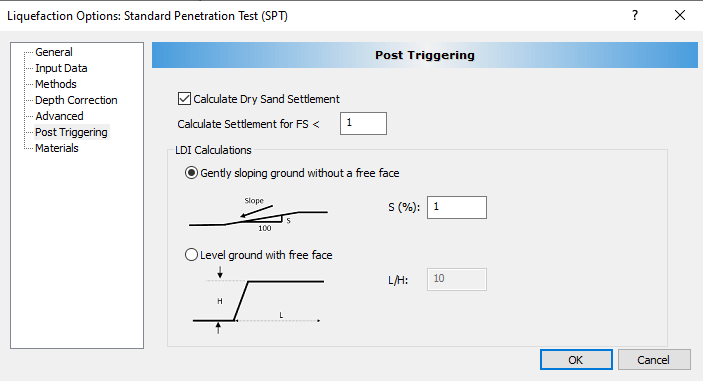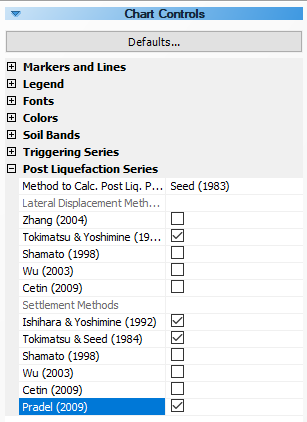Analysis Methods - SPT
Triggering
A number of methods are available for liquefaction triggering. The most widely used approach consists of comparing the cyclic stresses with cyclic resistance of the soil (comparing CSR and CRR). Liquefaction is expected where induced stresses exceed the soil resistance.
The following methods are available for triggering of liquefaction:
- Seed et al. (1984)
- NCEER (1997)
- Boulanger and Idriss (2004)
- Cetin et al. (2004) Deterministic
- Japanese Bridge Code (1990)
- Cetin et al. (2004) Probabilistic
- Liao et al. (1998) Probabilistic
- Youd and Noble (2001) Probabilistic
Settlement
Liquefaction settlement calculated in Settle3 is caused by the reconsolidation of the liquefied soil. Reconsolidation strains are calculated, based on the maximum shear strains that developed during the cyclic loading. The following methods are available for determining the volumetric strain.
- Ishihara and Yoshimine (1992)
- Tokimatsu and Seed (1987)
- Shamato et al. (1998)
- Wu et al. (2003)
- Cetin et al. (2009)
Dry Sand Settlement
During dynamic shaking, it is well known that loose sands tend to compress and settle. During severe shaking, this can cause liquefaction of saturated deposits. However, for dry sands liquefaction cannot occur since no water is present. For dry sands, dynamic shaking only causes the sand to compress and settle. The settlement addressing the seismic shaking is calculated in Settle3 using two different methods depending on the user input. If the user selects the Liquefaction method as Standard Penetration Test (SPT) then Settle3 will follow the SPT Dry Sand Settlement method by relating the volumetric strain to the cyclic shear strain and the earthquake magnitude (Pradel, 1998)
Conditions for dry sand settlement and post triggering settlement calculations
- Factor of Safety
- Piezometric line below soil model
- LDI calculations
Note that Settle3 will calculate dry ground settlement when Factor of Safety (FS) is less than the factor of safety cutoff, which is obtained from Post-Triggering option.

You can select Dry Sand Settlement under Liquefaction Analysis Options to see the results as shown below.
Settle3 will calculate dry sand settlement for soil model that is above the water table. Make sure to first have the piezometric line in the soil model, then assign the water table to the soil layers by selecting Groundwater > Soil Groundwater properties > Apply To All.
This allows users to choose option for the settlement calculation whether the soil model has gently sloping ground without free face, or there is any level ground with free face. S(%) is given in percentage of the slope for the sloping ground, while L/H is the ratio of the length of the surface to height of the level ground.
You can check the settlement by selecting Pradel (1998) in liquefaction analysis options dialog.

Or after results have been plotted in liquefaction graph, go to Chart Controls > select Pradel option under Post liquefaction Series and you will see the dry sand settlement in the graph.

Lateral Displacement
The lateral displacement is calculated based on the maximum shear strain. The following formulations are available in Settle3.
- Zhang Robertson and Brachman (2004)
- Tokimatsu and Seed (1987)
- Shamato et al. (1998)
- Wu et al. (2003)
- Cetin et al. (2009)
References for these documents can be found here.